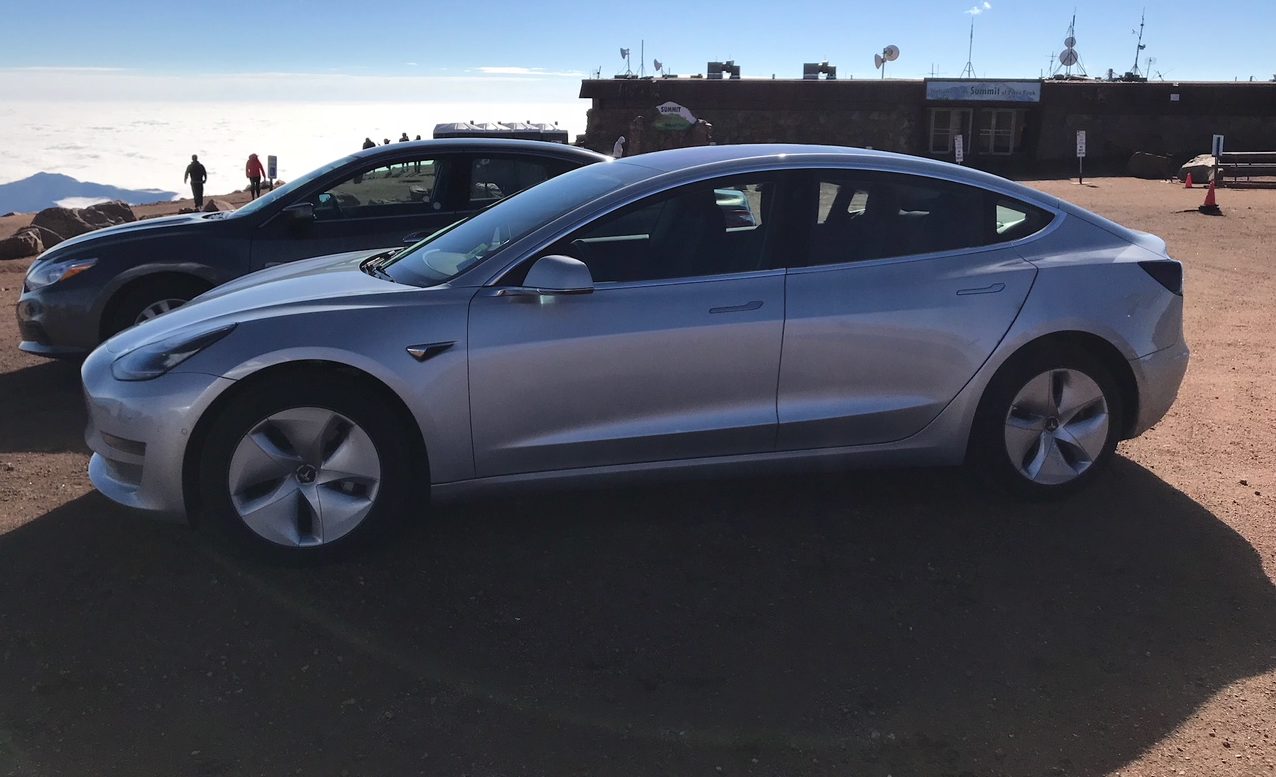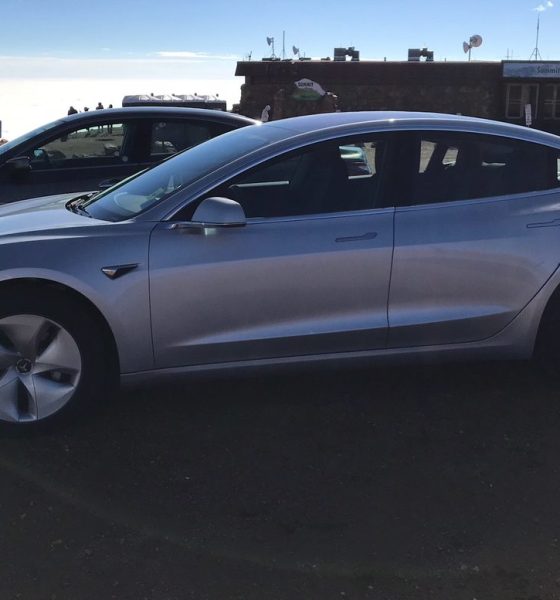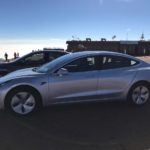

Lifestyle
Tesla Model 3 takes on Pikes Peak hill climb in performance and range test
An unmodified Tesla Model 3 took on the famed climb to the 14,000-ft summit of Pikes Peak, the site of one of the most intense hill climb events in the automotive world. As noted by the Model 3’s owner, the compact electric car handled the 12.42-mile climb flawlessly, with no signs of performance degradation.
The man behind the wheel of the Model 3 was Peter Lafford, who was featured in a previous article for his stunning and clever mod to his vehicle’s 18-inch Aero Wheels. Peter had taken on Pikes Peak multiple times in the past, several of them driving an internal combustion vehicle. In a conversation with Teslarati, Peter recalled an instance when he and his father had to slow down their car to a crawl just to reach the summit, leaving behind vehicle after vehicle that were stalled on the side of the road.
- The Tesla Model 3 at the top of Pikes Peak. [Credit: Peter Lafford]
- A photo taken during the drive up to Pikes Peaks summit. [Credit: Peter Lafford]
- The Tesla Model 3s Summit Pass for Pikes Peak. [Credit: Peter Lafford]
Being the go-to track for uphill endurance races, Pikes Peak features 156 turns and a change of elevation of almost 5,000 feet. This means that as the car climbs higher, the vehicle gets less oxygen from the thinner air, effectively sapping performance from both vehicle and its driver. In this sense, electric vehicles, whose electric motors do not get affected by low oxygen levels, have an inherent advantage in Pikes Peak. This was proven recently when Volkswagen’s I.D. R vehicle — an electric supercar designed to tackle the hill climb — shattered the all-time record for the Pikes Peak Challenge, reaching the summit in just 7:57.148.
While Peter Laffords’ Pikes Peak run in the Model 3 was limited by speed restrictions for civilian drivers in the area, a video of the drive shows just how well the compact electric car took the turns and the steep climb without breaking a sweat. As could be seen in footage from his run, Peter drove his car spiritedly. He began the hill climb with an 80% battery state of charge and reached the summit with 60%. Using the vehicle’s regenerative braking (set to Standard), he was able to regain 8% worth of range, returning with a 68% state of charge by the time he reached the toll booth at the bottom.
Peter’s climb up to the summit of Pikes Peak stands as yet another feat for Tesla’s compact electric car. Over the past months, the vehicle has started gaining a reputation as a solid electric car that can handle spirited driving for extended periods of time. Just recently, a Model 3 with aftermarket suspension and brakes took the pole position at the Canadian Sport Compact Series Time Attack series, beating a Porsche Boxter and a Mazda RX-8 and finishing 5th overall from a lineup of more than a hundred vehicles.
What’s particularly impressive, however, is the fact that all Model 3 currently on the road today are non-Performance Long Range RWD versions of the electric car. Thus, the automotive world is yet to witness the true capability of a Model 3 that is built from the ground up to be a performance vehicle.
Watch Peter’s silver Model 3 take on the final miles of the Pikes Peak hill climb in the video below.

Lifestyle
Tesla Model S Plaid battles China’s 1500 hp monster Nurburgring monster, with surprising results
There is just something about Tesla’s tuning and refinement that makes raw specs seem not as game-changing.

The Tesla Model S Plaid has been around for some time. Today, it is no longer the world’s quickest four-door electric sedan, nor is it the most powerful. As per a recent video from motoring YouTube channel Carwow, however, it seems like the Model S Plaid is still more than a match for some of its newer and more powerful rivals.
The monster from China
The Xiaomi SU7 Ultra is nothing short of a monster. Just like the Model S Plaid, it features three motors. It also has 1,548 hp and 1,770 Nm of torque. It’s All Wheel Drive and weighs a hefty 2,360 kg. The vehicle, which costs just about the equivalent of £55,000, has been recorded setting an insane 7:04.957 at the Nurburgring, surpassing the previous record held by the Porsche Taycan Turbo GT.
For all intents and purposes, the Model S Plaid looked outgunned in Carwow’s test. The Model S Plaid is no slouch with its three motors that produce 1,020 hp and 1,420 Nm of torque. It’s also a bit lighter at 2,190 kg despite its larger size. However, as the Carwow host pointed out, the Model S Plaid holds a 7:25.231 record in the Nurburgring. Compared to the Xiaomi SU7 Ultra’s record, the Model S Plaid’s lap time is notably slower.
Real-world tests
As could be seen in Carwow’s drag races, however, Tesla’s tech wizardry with the Model S Plaid is still hard to beat. The two vehicles competed in nine races, and the older Model S Plaid actually beat its newer, more powerful counterpart from China several times. At one point in the race, the Xiaomi SU7 Ultra hit its power limit due to its battery’s temperature, but the Model S Plaid was still going strong.
The Model S Plaid was first teased five years ago, in September 2020 during Tesla’s Battery Day. Since then, cars like the Lucid Air Sapphire and the Xiaomi SU7 Ultra have been released, surpassing its specs. But just like the Model Y ended up being the better all-rounder compared to the BYD Sealion 7 and the MG IM6, there is just something about Tesla’s tuning and refinement that makes raw specs seem not as game-changing.
Check out Carwow’s Model S Plaid vs Xiaomi SU7 drag race video below.
Lifestyle
500-mile test proves why Tesla Model Y still humiliates rivals in Europe
On paper, the BYD Sealion 7 and MG IM6 promised standout capabilities against the Model Y.

BYD is seeing a lot of momentum in Europe, so much so that mainstream media has taken every opportunity to argue that the Chinese automaker has beaten Tesla in the region. But while BYD sales this year in Europe are rising and Tesla’s registrations remain challenged, the raw capabilities of vehicles like the Model Y are difficult to deny.
This was highlighted in a 500-mile challenge by What Car? magazine, which showed that the new Tesla Model Y is more efficient, cheaper to run, and more reliable than rivals like the BYD Sealion 7, and even the nearly 400 KW-charging MG IM6.
Range and charging promises
On paper, the BYD Sealion 7 and MG IM6 promised standout capabilities against the Model Y. The Sealion 7 had more estimated range and the IM6 promised significantly faster charging. When faced with real-world conditions, however, it was still the Model Y that proved superior.
During the 500-mile test, the BYD nearly failed to reach a charging stop, arriving with less range than its display projected, as noted in a CarUp report. MG fared better, but its charging speeds never reached its promised nearly-400 kW charging speed. Tesla’s Model Y, by comparison, managed energy calculations precisely and arrived at each stop without issue.
Tesla leads in areas that matter
Charging times from 25% to 80% showed that the MG was the fastest at 17 minutes, while Tesla and BYD were close at 28 and 29 minutes, respectively. Overall efficiency and cost told a different story, however. The Model Y consumed 19.4 kWh per 100 km, compared to 22.2 for MG and 23.9 for BYD. Over the full trip, Tesla’s charging costs totaled just £82 thanks to its supercharger network, far below BYD’s £130 and MG’s £119.
What Car? Magazine’s testers concluded that despite BYD’s rapid sales growth and the MG IM6’s seriously impressive charging speeds, Tesla remains the more compelling real-world choice. The Model Y just offers stability, efficiency, and a proven charging infrastructure through its Supercharging network. And as per the magazine’s hosts, the Model Y is even the cheapest car to own among the three that were tested.
Watch What Car? Magazine’s 500-mile test in the video below.
Lifestyle
Tesla Cybertruck slapped with world’s least intimidating ticket, and it’s pure cringe
One cannot help but cringe and feel second-hand embarrassment at the idea of a person just driving around with a stack of these babies.

A Cybertruck parked at Stanford Shopping Center in California was recently hit with what might be the most try-hard piece of paper ever slipped under a wiper blade: a “fake citation” accusing the driver of supporting a “fascist car.”
The note, shared on X by Tesla staff program manager Ryan Torres, quickly made the rounds on X, where it quickly gained attention as an example of how not to protest.
The world’s least intimidating ticket
According to the citation, the supposed “violation” was “driving a fascist car.” The remedial action? Take the bus, call an Uber, or ride a bike. The note also dubbed Elon Musk a “chainsaw-wielding Nazi billionaire.” Now, protests against Tesla and Elon Musk have become commonplace this year, but one cannot help but cringe and feel second-hand embarrassment at the idea of a person just driving around with a stack of fake anti-Tesla/Musk citations.
Torres pointed out the irony himself in his post on X. Tesla currently employs over 140,000 Americans, and SpaceX has put the U.S. firmly back at the top of space technology. As Torres put it, maybe the person behind the world’s least intimidating ticket should “read a book on innovation before vandalizing” other people’s property.
Peak performative clownery
Not to mention that the fake ticket’s logic collapses under its own weight. EVs like the Cybertruck are literally designed to reduce emissions, not “destroy the economy.” If anything, Tesla has bolstered the United States’ economy by fueling jobs in engineering, manufacturing, and clean energy. It’s not the first time a Tesla has been the target of vandalism or politically charged notes, but this one stands out for sheer cringe value.
Torres summed it up neatly: “Peak clownery.” On that point, at least, the citation earns full marks. In a way, though, perhaps cringe fake tickets are not as bad as the literal firebombs that were being thrown at Tesla stores and cars earlier this year because some critics were gleefully misinformed about Elon Musk.











